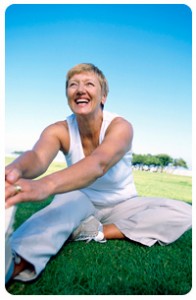Mobility Issues? We can help!
As we age our flexibility decreases and mobility issues begin to occur. A very easy common solution is stretching. It turns out that recently stretching has become a controversial issue. Popular literature has begun talking about some of the drawbacks of static stretching (New York Times link). Static stretching is “traditional stretching” when you hold a position at the end of a range of motion. Recent academic literature questions if stretching prevents injury, decreases muscle soreness or improves muscle length. The limitation of these studies are that they were performed on healthy subjects and it is really hard to quantify risk of injury.
The first thing to consider is when should you be working on your flexibility. 
After the the workout is the best time for flexibility work. At this point it is well proven that static stretching prior to activity decreases muscle strength, power and explosiveness. The attached link is to an abstract of a meta-analysis regarding stretching and performance (Link). Studies have demonstrated that if you stretch prior to activity you will not jump as high, hit a golf ball as far or produce as much force with your muscles.
Doing a dynamic warm-up is a much better option than static stretching prior to activity. When I say dynamic warm-up what I mean is movements that are performed to loosen up and promote good blood flow, increase body temperature and enhance muscle pliability. The exact warm-up should be catered to the specific activity that you are performing. Some of my favorite warm-ups include arm and leg swings, torso rotations,lunges and bowing and extending your low back. This is a generic set of warm-ups but it prepares your body to participate in activity.
Other good alternatives to static stretching would include PNF stretching, foam rolling or mobilization with movements techniques.
Regardless of the specific technique that you are using it is important to follow some guidelines including.
1: Controlled Stretching: Flexibility activities should be performed in a controlled fashion and you should not bounce into the very end-range of your movement. There is a chance of injury if you bounce into your end-range or if you are not stretching in a controlled manner.
2: Don’t stretch into pain: If something is painful you are not going to get the full benefit of the exercise. If your brain is getting a pain signal you are not going to be able to relax and get a stretch.
2: Stable spine: Another thing to think of is your trunk position. If you are stretching an extremity it is important to maintain a stable trunk position. I see this all of the time in the clinic. People don’t feel a stretch in the correct place because they are letting their spine be too loose and not engaging their abdominal muscles.
The muscles that you should focus on are a little more tricky. Generically I would suggest that you focus on shoulder, mid-back hip and ankle flexibility. Again this is a generic suggestion for areas where most people tend to be stiff. If you are injured or in pain you would likely benefit from a more specific mobility routine.
If you need help with a specific mobility routine contact us at PHYSIO Physical Therapy and Wellness in North Asheville.
Christopher Taylor, MPT
PHYSIO Physical Therapy and Wellness
660 Merrimon Ave, Ste C
Asheville, NC 28804
(828) 348-1780
https://www.PhysioWNC.com

